More and more people in Japan have come to perceive the rise of China as a threat, prompted by the sharp contrast between the growth performance of the two countries in recent years. It should, however, be noted that the economic relations between Japan and China can be characterized as complementary rather than competitive, reflecting the prevailing gap in the level of development. Both sides can benefit by promoting a division of labor according to comparative advantage, with China specializing in labor-intensive products and Japan specializing in high-tech products. To this end, Japan needs to facilitate the relocation of declining industries to China, while at the same time proceed boldly with its structural reform.
From unwarranted pessimism to unreserved optimism
Not too long ago, most Japanese were concerned about the future of their gigantic neighbor. Political risks aside, they worried if China would be forced to devalue its currency amid financial turmoil in neighboring countries; if it would default its external debt; if its banking sector would collapse on the weight of its mountain of bad debt; and who would feed China?
This pessimism has suddenly turned into unreserved optimism over recent months. Now the Japanese media abound with speculation that China is leapfrogging into the new economy without going through the cumbersome process of industrialization, and that China will soon overtake Japan as "the factory of the world," if not its position as Asia's number one economic power. Some people even suggest that China should allow its currency to revalue to help Japan out of its recession.
The relative strength of the Chinese economy amid a global recession, and China's WTO accession and hosting of the 2008 Olympics in Beijing have certainly contributed to the euphoria. But let us not forget that the Chinese economy is slowing down on the back of weaker export growth; that WTO accession involves expensive costs in terms of rising bankruptcy and unemployment (at least in the short term) and lower investment in industries that can no longer be protected by high tariffs; and that hosting the Olympic Games in Beijing will divert investment funds from the national project of developing the western part of the country.
In the absence of any significant improvement in China's economic fundamentals, the sharp change of Japan's perception of China is simply a reflection of the loss of confidence among its people as the recession at home deepens day by day.
An objective evaluation of the Chinese economy
Thus until a year ago, most people tended to underestimate China's economic power, but now the pendulum has swung to the other extreme. Any objective evaluation of China's economic strength should take into consideration the following factors.
First, economic strength depends on the size of the Chinese economy, not its rate of growth. Although China has been growing at an annual rate of almost 10 percent over the last twenty years, its GDP is still only a quarter that of Japan. Taking into consideration the fact that China's population is ten times that of Japan, its per capita GDP, at less than $1000, is only one-fortieth (that is, 2.5%) that of Japan. Although adjusting for the purchasing power of the Chinese currency multiplies China's GDP by four times, it does not change the fact that China is still a very poor country, with its global ranking in terms of per capita GDP improving only marginally from 140 to 128 by shifting to the purchasing-power-parity (PPP) measure, according to the World Bank.
Second, the booming coastal region represents only a fraction of the Chinese economy. Shanghai has a per capita GDP of over $3000, which is about 10 times as high as that of the inland province of Guizhou. It will take a long time for coastal China to catch up with the industrialized countries and even longer time for the rest of China to do the same.
Third, China is heavily dependent on foreign investment, technology, and key parts and components. Half of China's exports are composed of products made by foreign companies that bring in funds and technology. Even for local firms that involve no foreign ownership, a large percentage of their exports take the form of outward processing with foreign partners providing the funds, technology, product designs, key parts and components, and marketing channels. Thus, for a $1000 laptop computer "made in China," the "value added" (mostly labor cost) that is truly indigenous Chinese would be a fraction of its price after discounting for the costs of imported parts and components (such as the Intel-made CPU), as well as the interest, dividends, and licensing fees paid to foreigners.
Major development indicators at the national level show that China still lags behind Japan by about forty years. At present, China's life expectancy at birth, infant mortality rate, primary sector as a percentage of GDP, Engel's coefficient, and per capita electricity consumption, are similar to those of Japan at around 1960. If China's economy continues to grow at its current high rate, this gap will narrow, and within the next 20 years China's GDP may actually surpass that of Japan. Even then, however, China's per capita GDP will still only be one tenth that of Japan.
The flying geese model of Asian economic development
The spreading of the wave of industrialization from Japan to the Asian NIEs (South Korea, Taiwan, Hong Kong and Singapore) and then further to ASEAN (Indonesia, Malaysia, the Philippines, and Thailand) and China during the postwar period has been characterized by the "flying-geese model." Countries specialize in the exports of products in which they enjoy comparative advantage commensurate with their levels of development, and at the same time they seek to upgrade their industrial structures through augmenting their capital stock and technology. Foreign direct investment from the more advanced countries to the less developed ones, through relocating industries from the former to the latter, plays a dominant role in sustaining this process.
With the onset of the Asian crisis, and contrasting growth performance between Japan and China in recent years, it has become fashionable to advocate that, the rise of China, supported by the IT revolution, has rendered the flying geese model irrelevant in describing the division of labor among Asian countries. A closer look at the evolution of the trade structure of Asian countries over time, however, shows that the geese are still flying in an orderly manner.
It is certainly true that much progress has been made in China's industrialization over the last twenty years; manufactured goods now account for 90% of total exports, up from 50% in 1980. Still, China's competitiveness in international markets is mainly based on the abundant supply of cheap labor, broadly in line with its level of economic development. Chinese exports are dominated by labor-intensive products, such as textiles, and in product categories that are considered high-tech, China's main role is still in labor-intensive processes, such as assembling. Despite a gradually shrinking gap between the forerunners and latecomers in the process of economic development, Japan continues to lead other Asian economies in terms of income level as well as competitiveness in high-tech industries, with the Asian NIEs, the ASEAN countries, and China (in this "traditional" order) catching up from behind ( figure 1 ).
Figure 1:The flying geese pattern of Asian countries' exports (In terms of exports to the United States)
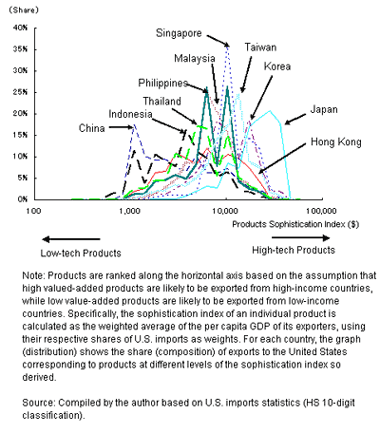
China as a newly industrializing country
In line with the "flying-geese pattern of economic development," a country's comparative advantage usually shifts from the production of primary commodities to labor-intensive manufactured goods and later on to capital- and technology-intensive products. These shifts are reflected in its trade structure, which progresses from that of a developing country to that of a newly industrializing country and finally to that of an industrialized country.
A country's comparative advantage structure (as revealed by its trade structure) can be classified into one of four categories based on the relative magnitude of the specialization indexes of the country's primary commodities (SITC Sections 0-4), machinery (SITC Section 7, a proxy for capital- and technology-intensive products), and other manufactures (SITC Sections 5, 6, 8, 9, a proxy for labor-intensive products). For a particular industry, the specialization index is defined as its trade balance divided by the volume of two-way trade (that is [exports - imports]/[exports + imports]). By definition, the value of the specialization index ranges from -1 to +1, with a higher value implying stronger international competitiveness for the industry concerned. A country typically passes from one category to another in the following sequence:
1) the developing country stage, with primary commodities more competitive than other manufactures and machinery,
2) the young NIE stage, with other manufactures becoming more competitive than primary commodities, which maintains its lead over machinery,
3) the mature NIE stage, with machinery overtaking primary commodities while other manufactures maintain their overall lead,
4) the industrialized country stage with machinery overtaking other manufactures, which maintain their lead over primary commodities.
Most Asian countries have followed these stages in the course of economic development, with some moving faster than others.
Applying the present framework to China confirms that the country's comparative advantage structure has undergone a process of rapid transformation since it started its ambitious reform program in the late 1970s ( figure 2 ). Starting as a typical developing country, China became a young NIE in 1992 when the specialization index of other manufactures surpassed that of primary commodities. Subsequently, it attained mature NIE status in 1999 when the specialization index of machinery also overtook that of primary commodities. The current comparative advantage structure of China corresponds to that of Taiwan in the early 1970s.
Figure 2:Stages of China's trade structure
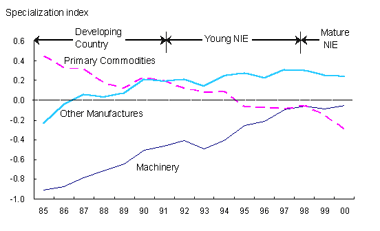
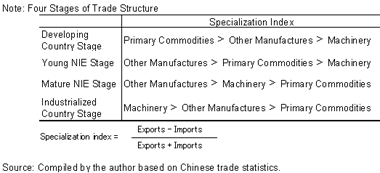
Japan to benefit from the rise of China
Although China's growing economic power may pose a threat to the ASEAN economies (with which it is competing), it should prove beneficial to Japan (whose economy it tends to complement). This can be confirmed by analyzing the repercussions through trade and investment.
The development of the Chinese economy can be characterized by export-led growth based on its vast labor resources. China's industrialization increases the supply of labor-intensive goods to international markets while raising the demand for capital-intensive goods, leading to a decline in the prices of labor-intensive goods relative to capital-intensive goods. This implies a worsening of China's terms of trade (the ratio of export prices to import prices), and an improvement in the terms of trade for the rest of the world. Through this shift in relative prices, other economies are also able to benefit from the growth of the Chinese economy. For China itself, however, the deterioration in its terms of trade results in a decline in real income, partly offsetting the benefit of higher economic growth.
Among countries in the rest of the world, however, distinction should be made between winners and losers. On one hand, countries with trade structures complementary to that of China should gain because their import prices should fall relative to their export prices as China's terms of trade deteriorate. On the other hand, the reverse is true for countries with trade structures similar to that of China.
Generally speaking, the closer two countries are in their level of economic development, the more likely they are to be competing with each other, while the wider the gap in their level of economic development, the more likely they are to complement each other. For example, China's competitive relations with the ASEAN economies, where income levels are still low, and its complementary relations with the Asian NIEs, which are at a more advanced stage of economic development, more or less reflect the differences between its level of economic development and theirs. This is particularly apparent in the relationship between China and Japan, whose economies complement rather than compete with each other-just as the big difference in their levels of economic development would lead one to expect ( figure 3 ).
Our estimates show that China and Japan compete for only about 20% of their exports to the United States in value terms, although the percentage is growing. (This compares with figures of 5% in 1990 and 10% in 1995.) The figure would be even smaller if take into consideration the fact that, within each product category, exports from Japan tend to be up-market while those from China tend to be down-market and that "imported content" tends to be much higher in Chinese exports. Moreover, it is probably fair to say that any competition between the two is limited to low-added-value industries where Japan no longer enjoys a comparative advantage.
The emergence of China as an attractive destination for investment has also altered the flow of foreign direct investment in Asia. Again, the distinction between countries competing with China and those complementary to it holds the key to separating winners from losers. Higher-income countries rich in funds and technology are likely to benefit, while lower-income countries that compete with China for foreign capital are likely to suffer. Thus Japan and the Asian NIEs can get high returns by investing in China, while the ASEAN countries may suffer a diversion of investment funds to China.
Figure 3:Competition between China and Japan in the U.S. market
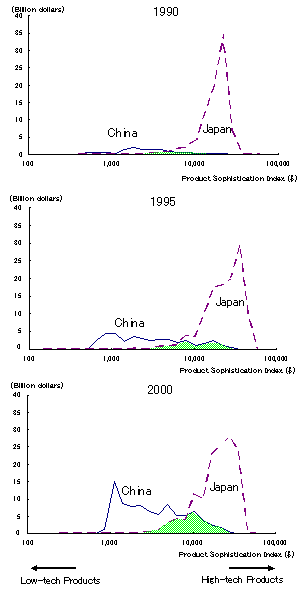
(Note) Products are ranked along the horizontal axis based on the assumption that high valued-added products are likely to be exported from high-income countries, while low value-added products are likely to be exported from low-income countries. Specifically, the sophistication index of an individual product is calculated as the weighted average of the per capita GDP of its exporters, using their respective shares of U.S. imports as weights. For each country, the graph (distribution) shows the amount of exports to the United States corresponding to products at different levels of the sophistication index so derived. For Japan, the area where the two distributions overlap each other (the shaded area in each diagram) as a percentage of Japan's total exports to the United States (as measured by the size of Japan's distribution) serves as an indicator of the degree of competition with China.
Source: Compiled by the author based on U.S. imports statistics (HS 10-digit classification).
Competition with China and Japan's deflation
With no economic recovery in sight, more and more people are blaming Japan's prolonged recession on growing competition with China. There is no doubt that rising imports of cheap products from China are putting downward pressure on Japan's price level, but this is not necessarily bad for Japan. Here we need to distinguish between "good deflation" and "bad deflation." The former results from cheaper imports that reduces the costs of production (and thus increase the profitability) of Japanese manufacturers, and is accompanied by an expansion of Japanese output. The latter reflects a diversion of demand from Japanese products to Chinese products in both the Japanese market and international markets, which reduces Japan's domestic production. The complementary relations between the two countries guarantee that the positive effect overrides the negative effect.
By the same logic, in contrast to general belief, an appreciation of the Chinese currency, as demanded by some business sectors in Tokyo, would not help solve Japan's economic woes. On one hand, the positive impact of a stronger yuan on Japan's global exports is minimal because the product mixes of the two countries' exports are so different. On the other hand, should a stronger yuan lead to a slowdown in the Chinese economy, Japanese exports to China would suffer.
Competition with China and Japan's shrinking trade surplus
In recent years, Japan, which has long been known for its massive trade surpluses, has begun to lose its Midas touch. In the short term this is largely the result of slower export growth (especially in the field of information technology), itself the result of a global economic slowdown. However, Japan's (annual) trade surplus has actually been declining for the past three years, and this has given rise to fears that factors that are more structural in nature may be at work.
One of these fears is the view that China's growing economic power may be the main factor in the decline of Japan's trade account surplus. Chinese exports to Japan-especially of machinery and equipment such as audio equipment, television sets and computers as well as textiles-have been growing at a double-digit rate since the late 1980s. In the first half of 2001, Chinese products accounted for more than 15% of Japan's imports-nearly as much as the 18.8% imported from the United States, the leading exporter to Japan. The main reason for this is the fact that Japanese companies have transferred much of their production to China in pursuit of lower production costs since China opened up its economy. At the same time, Chinese goods have also eroded Japan's share of export markets as China has become more industrialized, with Chinese refrigerators and audio equipment, for example, now accounting for a larger share of US imports of such goods than those from Japan.
Although it is true that Japan's trade deficit with China has been growing in recent years only ¥1 trillion of the ¥8 trillion decline in Japan's estimated trade surplus in 2001 from its peak level in 1998 can be attributed to China. Moreover, any attempt to measure the true scale of Japan's trade with China should take into consideration its trade with Hong Kong and Taiwan whose economies have been tightly integrated with the Mainland ( figure 4 ). Although Japan ran a trade deficit of ¥2.7 trillion with China in 2000 (compared with an overall trade surplus of ¥10.7 trillion), it was more than offset by Japan's large trade surpluses with Hong Kong and Taiwan, so that Japan turned out to have a trade surplus of ¥2 trillion with "Greater China."
One should also be reminded that, at a more fundamental level, trade and current account imbalances reflect imbalances between savings and investment. In the 1970s and 1980s, when friction between Japan and the United States mounted amid a rising trade imbalance between the two countries, Japan correctly diagnosed the immense fiscal deficit of the United States as the major source of the problem. By the same logic, Japan's shrinking trade surplus should be interpreted as a reflection of its rising budget deficit incurred in the name of fiscal stimulation.
Figure 4:Japan's trade balance by region
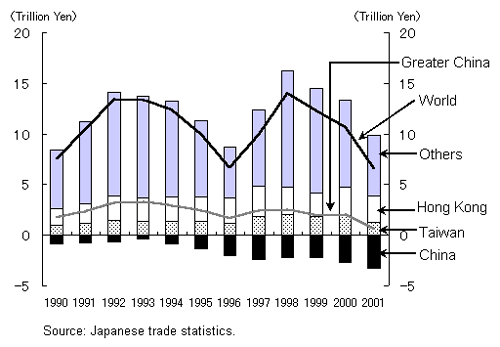
The rise of China and Japan's hollowing-out problem
The rise of China is posing both challenges and opportunities for Japan. For many Japanese companies, China is a potential market and destination for investment. For others, increasing imports from China have given rise to the need for industrial restructuring at home. In sectors that compete with China, this may take the form of more bankruptcies and higher unemployment. This situation has led to growing fears of a "hollowing out" of domestic industries and escalating trade friction between China and Japan.
Japan should not respond to these challenges through the use of protectionist policies to safeguard domestic industries that have lost export competitiveness. The establishment of barriers to limit imports and to prevent declining industries from being transferred oversea is like treating the symptoms instead of the disease. Declining industries in Japan are unlikely to recover their competitiveness as a result of government protection. Such policies merely delay the improvement of industrial structure in both Japan and China.
Rather, Japan should seek a division of labor with China according to comparative advantage. This means promoting new growth areas through deregulation and investing in research and development at home, while, at the same time, relocating declining industries to, and expanding imports from, China. This strategy should not only help promote China's economic development but also free up resources for emerging industries in Japan. By increasing imports from China, Japanese producers and consumers should realize gains in real income by lowering the nation's costs of production and imports.
The ultimate goal of the flying-geese model of economic development is the convergence of all nations in the region to the living standards enjoyed by industrialized countries and the development of a horizontal division of labor among Asian nations. The per capita GDP of the NIEs has already reached the standard of OECD member countries, and the era of Japan being the only industrialized country in Asia has ended. But a lower relative position for Japan's economy does not necessarily mean an absolute decline in the living standards of its citizens. Trade and direct investment are by no means zero-sum games, and it is possible for all the economies in the region to benefit by enlarging the size of the pie. Indeed, the latest financial crisis in Asia vividly illustrated that it is in Japan's own national interest to be surrounded by affluent and peaceful countries rather than by poor and unstable ones.


